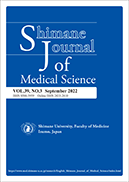39 巻, 3 号
選択された号の論文の3件中1~3を表示しています
- |<
- <
- 1
- >
- >|
Original Article
-
原稿種別: Original Article
専門分野: Biology, Life Sciences and Basic Medicine
2023 年 39 巻 3 号 p. 77-93
発行日: 2023/03/20
公開日: 2023/03/20
PDF形式でダウンロード (1917K) HTML形式で全画面表示 -
原稿種別: Original Article
専門分野: General Medicine, Social Medicine, and Nursing Sciences
2023 年 39 巻 3 号 p. 95-104
発行日: 2023/03/20
公開日: 2023/03/20
PDF形式でダウンロード (2198K) HTML形式で全画面表示 -
Electroconvulsive Treatment Ameliorates Lipopolysaccharide-induced Depressive Like Behaviour in Rats原稿種別: Original Article
専門分野: General Medicine, Social Medicine, and Nursing Sciences
2023 年 39 巻 3 号 p. 105-112
発行日: 2023/03/20
公開日: 2023/03/20
PDF形式でダウンロード (713K) HTML形式で全画面表示
- |<
- <
- 1
- >
- >|
